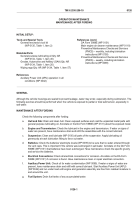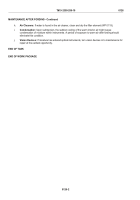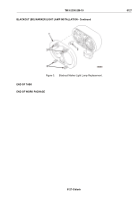TM-9-2350-256-10 - Page 723 of 796
OPERATOR MAINTENANCE
EXTREME HOT WEATHER MAINTENANCE
INITIAL SETUP:
Tools and Special Tools
General mechanic's tool kit
(WP 0135, Table 1, Item 2)
Materials/Parts
General purpose lubricating oil Qty: AR
(WP 0134, Table 1, Item 45)
Silicone compound Qty: AR
(WP 0134, Table 1, Item 61)
Wiping rags Qty: AR (WP 0134, Table 1, Item 57)
References
Lubrication instructions (WP 0101)
TM 9-6140-200-13 (WP 0131)
EXTREME HOT WEATHER MAINTENANCE
Check the following components:
Batteries
•
Electrolyte Level (If Applicable) —
In hot climates, check electrolyte level daily In Accordance With
(IAW) TM 9-6140-200-13.
•
Specific Gravity (If Applicable) —
Batteries should have a weaker electrolyte in hot areas
(1,200 to 1,225 at full charge) IAW TM 9-6140-200-13. Have specific gravity level checked
by maintenance.
•
Self-Discharge —
A battery will self-discharge faster if left standing for long periods in high temperatures.
If the vehicle is parked for several days, have the batteries removed by maintenance and stored in a cool
place IAW TM 9-6140-200-13.
Hull and Crew Compartment
In hot, damp areas, corrosion will occur on all parts of the materiel. It appears as rust and paint blisters on metal
surfaces and mildew, mold, or fungus growth on fabric and glass. Protect all unfinished, exposed metal surfaces
with a film of general purpose lubricating oil. Cables and terminals should be protected by silicone compound.
Armament
Inspect parts often for moisture or corrosion. Thoroughly dry all exposed, unpainted surfaces such as machine
gun bore, breech and fire mechanisms, and oil as prescribed in Lubrication Instructions (WP 0101) in dry, dusty,
or sandy areas, leave exposed surfaces, such as recoil stress, free of oil or preservative. Combining the oil with
sand makes an abrasive paste far more damaging than no oil at all. At other times keep these surfaces lubricated
to prevent rusting.
TM 9-2350-256-10
0130
0130-1
Back to Top




















